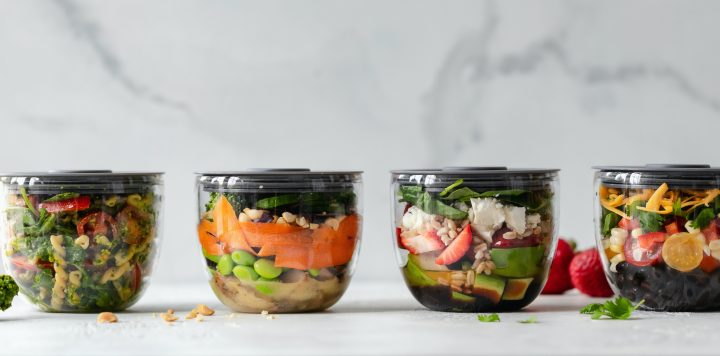ADULTING (SORT OF)
Drafting a meal plan that suits your lifestyle and budget

By planning meals in advance, you can ensure your diet contains all the nutrients you need while staying within a healthy budget. Here’s how.
Planning a menu for meals in advance is one way to stay on top of your diet and your food budget. Sandi van Zyl, a registered dietitian, calls this practice a “game changer” to ensure that one does not get caught out by the busyness of life when it comes to your nutrition.
“Planning your meals ahead of time ensures that you’re not resorting to takeaways or eating calorie-dense, low-nutrient foods all the time. This in turn will not only save you money but will also nourish your body and mind and reduce your risk of developing health issues down the line,” Van Zyl explains.
The first element to consider when drafting a meal plan is the budget. This determines the type of meals one can afford to make and how certain food groups can be included, Hannah Kaye, a health and wellness consultant who specialises in nutrition, tells Maverick Life.
For example, meat-eaters can look at their budget and establish “how often [they] can include animal products like meat, chicken or fish”, Kaye says. “Once you’ve done that, you can slot those into your dinners and build more plant-based meals around them.”
Next, it is important to make sure that the plan meets both an individual’s own calorie and nutrient requirements, says Van Zyl.
“Factors to consider include how active you are, whether you’ve been diagnosed with a specific health condition, and your personal body composition goals. It also needs to be practical and budget-friendly if it’s going to last. “If you’re not sure how much you should be eating, it might be a worthwhile investment speaking to a dietitian,” she notes.
Finally, Kaye encourages people to check what ingredients they already have in their cupboards and incorporate them into the menu. “It’s amazing what you can make with what you already have handy,” she says.
Filling your plate
For each meal, Van Zyl recommends incorporating a balance of fibre-rich foods, protein and healthy fats into each meal or snack.
“By doing this, you’re more likely to meet your daily requirements for protein, carbs, fat, fibre, and all the vitamins and minerals,” she explains. “If you’re an omnivore, think lean proteins where possible and eat a combination of plant and animal protein.”
According to Van Zyl, good sources of plant protein include:
- Legumes (chickpeas, lentils, beans, soya, peanuts).
- Quinoa.
- Nuts and seeds.
“When eating animal protein, aim for a portion size roughly equivalent to your fist and your whole hand (including fingers) if eating fish.”
Grains and starchy vegetables should take up roughly a quarter of the plate, and the rest of your plate should be filled with non-starchy vegetables such as:
- Green leafy vegetables.
- Peppers.
- Mushrooms.
- Courgettes.
- Gem squash.
- Broccoli.
- Cauliflower.
“It’s incredibly important that vegetables are a big feature in a meal plan so that ultimately, whatever meal you eat, your veggies take up half the plate. That way, you’re sure to be getting a decent amount of nutrients,” Kaye explains.
“Next, plan your protein – that can be animal-based or plant-based. You can then plan your whole grains or higher carb vegetables, and, finally, some good fats – like olive oil.”
A good example that includes all of these would be roast chicken, broccoli, sweet potato and olive oil to cook with, Kaye illustrates.
Planning ahead and storing
Both Van Zyl and Kaye believe that planning meals week by week is the best starting point for the average person.
“If you plan too far ahead, you’re more likely to be caught off guard with social and work events that creep onto the calendar. Planning weekly is ideal and it is more likely to become a long-term habit versus planning monthly,” Van Zyl says.
“That said, it’s important that you put time into the calendar and stick to it. You’ll likely need about 2-3 hours for planning, shopping and basic food prep for the week ahead. It’s a worthwhile investment in your time and will end up saving you a lot of time during the week, when you need it most.”
Also, Kaye notes that “one should always cook double in the evening so you have leftovers for the next day’s lunch, which you can always just pair with a salad.”
While keeping a weekly menu is more manageable, it can be handy to store food for a later date when possible – “ideally in glass containers to avoid the harmful chemicals in plastics”, Kaye notes.
“Freezing meals is a wonderful time-saver during the week and allows you to build up a collection of different meals so that you don’t end up eating the same meal three or four times in a row,” Van Zyl says, especially for people who live alone or cook for one. “It might mean a bit of extra work in the beginning, but it will pay off.”
“Making a big pot of stew or stir-fry works well. Even something like spaghetti bolognese freezes well. If you prefer the pasta or rice part of the dish fresh, then cook only the sauce or stew part and freeze that and then cook up some rice or pasta on the night you eat it.”
“Whole-wheat couscous is another easy, quick-to-prepare grain that can accompany stew and bolognese sauce alike. Making some nice vegetable and legume soup (red split lentils are great) in winter is another winner,” Van Zyl recommends.
Storing bread in the freezer and taking it out slice-by-slice only when you need it is another handy trick to avoid food waste, she adds.
However, Kaye notes that storing meals during load shedding may be more difficult, and could result in food waste during those extended power outages when meals defrost and go off. To be safe, she recommends storing vegetarian meals with plant proteins, as it is less of a problem if they defrost. “Making a chickpea casserole or a lentil bolognese and storing would be a great idea – same goes for soups,” Kaye says. “But for anything with chicken (for example), I’m not sure I’d be making it in bulk right now.”
If freezing food is possible in your household, Van Zyl also recommends having frozen berries for smoothies and frozen vegetables.
“Frozen veg might also be a good, practical idea for some people who don’t have access to fresh veg all the time, or who find they’re wasting it by not using it before it reaches its best-by date,” she says.
Van Zyl also recommends other ingredients that are good to keep on hand in the kitchen:
- Tins of tuna, pilchards and sardines.
- Tins of chickpeas, lentils, kidney beans and black beans.
- Whole-grain or veg wraps for the week.
- Whole-grain crackers in the cupboard for quick snacks.
Most importantly, your meal plan needs to suit your individual needs and be manageable to your own lifestyle.
“Make it fun – try a new recipe out each week. You are much more likely to eat what you’ve bought if you aren’t super-bored of it already,” Kaye says.
“I have ‘Fancy Friday’ for new recipes… [and] ‘Taco Tuesday’ every week where I just shift around the protein.” DM/ML




















 Become an Insider
Become an Insider
Sarah, you have made my day. When Covid started my business suffered quite drastically and I had to learn how to operate a food budget. I now do a planned weekly shop and make up my Saturday to Friday Menu on a Friday evening and do a big shop on Saturdays. I found we could only eat meat or fish two or three times a week. I now cook mostly veggie meals, often with egg or cheese. I always make sure there are proteins on the dinner plate and use loads of lentils and beans. All the veggies you listed are my standard veggies, except the Quinua which is too expensive so I use Bulgar Wheat instead (I don’t like couscous) I set up a spreadsheet with all the ingredients I need and put the prices in the next column. If I go over budget I have to re-arrange the menu a bit. It can be quit daunting but I enjoy a challenge and LOVE food. H and I (we both cook) have a daughter who is vegan and lives in New York at the moment, She has influenced us quite a lot. My tip: You need to shop at at least three supermarkets to get the best variety and value for money. Fresh farmer’s markets are also great. Happy meal planning!